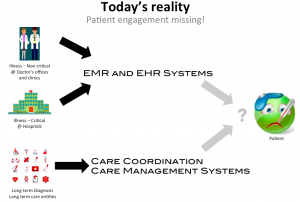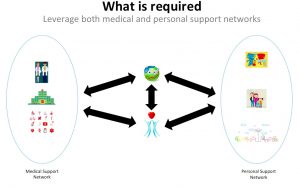Really? Is Patient engagement in Healthcare a miracle? You mean people taking care of themselves? …I thought this was obvious. Assumed knowledge.
Why is this being hailed as a miracle? A blockbuster drug?
However that sounds, patient engagement being a miracle rings true. Why? What is happening here?
Lets step back a bit.
We have made amazing strides in the field of medicine. Modern medicine can do things that were in the realm of science fiction just a few decades back. Like having the ability to transplant organs. Have targeted treatments based on your genetic make up. Do complex surgeries. Like, the ability for patients to get their knees replaced and often not have to spend even one night at the hospital.
These examples affirm that there are any number of stories that can shine a light on all the progress in medicine.
In all the focus on the health problems of patients, we have neglected the patient. I feel we need to look beyond Healthcare as we know it. We need to look at a person’s Wellness. We need to engage the patient in their own wellness. There is a lot of research to show that “…if patient engagement were a drug, it would be the blockbuster drug of the century…”
Healthcare a part of “Wellness Care”
We have discovered and invented new ways diagnosing and treatingpeople. And continue to discover more. However, treating people is one part of their Wellness Care. Treatment is an important part, but only a part.
So… what is the difference between Healthcare and Wellness Care? What is Wellness Care? And then try to figure out the difference between Healthcare and Wellness Care. As we figure out the aspects of Wellness Care that are not a part of “Healthcare”, we find that these aspects are neglected or underserved.
My hope is that this recognition, this gap, once identified will help direct our focus to the neglected aspects of Wellness Care. The identification of these ‘gaps’ could inform our future actions.
So… what is Healthcare?
Lets take a look at what the word Healthcare means to the patients and the Healthcare professionals.
Layman’s definition from the Merriam Webster Dictionary: Efforts made to maintain or restore physical, mental, or emotional well-being especially by trained and licensed professionals
The professional’s definition from the Medical Dictionary: The spectrum of health care has been defined as encompassing six levels of health care: Preventive care; Primary care; Secondary or acute care; Tertiary care; Respite care; Restorative care; and Continuing care
And Wellness Care?
According to National Wellness Institute: Wellness is a Conscious, self-directed and evolving process of achieving full potential; is Multidimensional and holistic, encompassing lifestyle, mental and spiritual well-being, and the environment; is Positive and affirming
How do Healthcare and Wellness Care differ?
Its obvious from these definitions that Healthcare is clearly a part of “Wellness Care”. And how are they different?
In unpackingthese definitions Healthcare and Wellness Care we find that they differ in three significant ways
- Provider Directed vs. Self Directed: First, Healthcare is led and directed by licensed Healthcare professionals whereas Wellness Care is self-directed. One can seek help from a licensed professional but it is led by the person in question – or the patient.
- Episodic vs. Holistic: Secondly, Healthcare is in the context of an illness or an ailment, long term or short term, continuing or episodic, whereas Wellness Care refers to a more all-encompassing and holistic approach to the stateof an individual – Physical, Mental, and Social.
- Clinical network vs Clinical and Social Network: Third – and this is very important, when we talk about Healthcare the primary stakeholders are the Providers and the Patients, very often neglecting the Social support network, which is an essential element of wellness care.
The situation today…
We have always known that the patient has to be a part of the conversation to maintain his or her health and wellness. This conversation is disconnected and disjointed today. While a part of this conversation happens through applications like EMRs, EHRs, exchanges; an equally significant part of this conversation like that between the providers and the patients or between the patients and their

social support network has moved in different directions.
This has led to a fragmented conversation. Its like people that need to talk are not in the same room. Different stakeholders in wellness of a patient that need to be in the same room to be able to talk to each other are in different rooms; each one is in a room of their choice. This leads to fragmented conversations.
We need to defragment this conversation.
Healthcare systems are becoming Patient Centric, however they remain provider led – of the providers, by the providers and for the providers. The principal beneficiary – the patient, is missing from the conversation.
This is clearly not enough.
So what do we need to do? How do we get in the same room? Engage the patient?
Today the patient is often ‘bolted on’ to this conversation. They are given access to a few documents like registration forms and discharge notes through an online patient portal. Nothing meaningful. It is no wonder then that the utilization of most of the patient portals remains low. This is not patient engagement.
As we saw, we have always known that Healthcare and Wellness care need patient involvement. Patient Engagement.
Put the patient in the middle! Patient engagement.

We need to put the patient in the middle of this conversation. The patients should be able to leverage not just the provider support community but also those parts of their social network that are important to their Healthcare and Wellness Care.
In a future post I will look at a patient’s journey through a Healthcare episode and see how what we need to do to maintain this patients Healthcare and Wellness Care. And this journey will hopefully give us clues on how to engage with patients.





